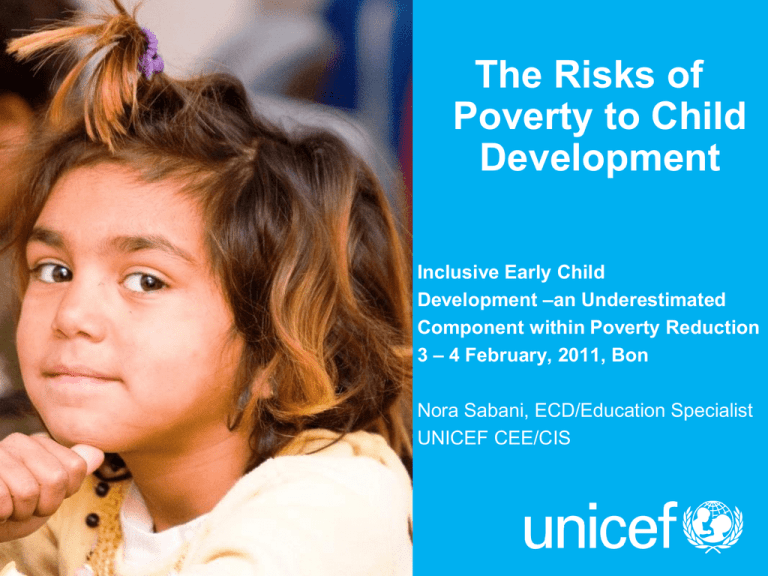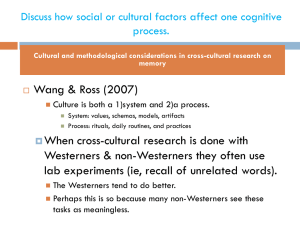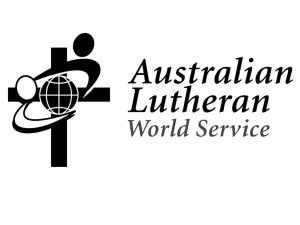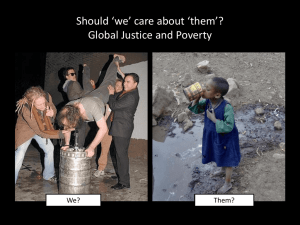CLICK AND TYPE TITLE HERE
advertisement

The Risks of Poverty to Child Development Inclusive Early Child Development –an Underestimated Component within Poverty Reduction 3 – 4 February, 2011, Bon Nora Sabani, ECD/Education Specialist UNICEF CEE/CIS UNICEF Global Priority Five Mid-Term Strategic Priorities (MTSPs) 2006-2013 MTSP 1- Young Child Survival and Development (mother and the child) MTSP 2- Basic Education and Gender Equality (3-6) MTSP 5- Policy, advocacy and partnerships for children’s rights Structure of presentation I. Knowledge about ECD II. Pathways to poor development III. Risk factor to poor development IV. Strategies and characteristics of sucessfull ECD programmes Knowledge about young child development Brain development is most rapid and vulnerable from conception to 5 years Insults and interventions can have lasting effects Young child development is esp. sensitive to negative effects from early undernutrition, deprivation of care and of responsive parenting, and ill treatment Knowledge about early childhood development programmes • Every child has a right to a good start in life and opportunities for reaching its full potential (CRC and other legal commitments) • Participation in ECD increases cognitive ability & behaviour on entry and in school, contributes to quality, productive and enjoyable life • Interventions are more cost effective than at other ages And yet... At least 200 million children aged under 5 years fail to reach their potential in cognitive and socio emotional development (Lancet Series of articles on ECD, 2007) Millions of children < 5y not fulfilling their potential in development (WHO, 2006; UNICEF 2006) 219m (39% of children <5y) 250 200 150 156m 126m 100 Stunted Poverty Both 50 0 Stunted Poverty Disadvantaged % of disadvantaged children <5yrs by region 70 60 50 40 30 20 10 0 S-S Africa Mid East & N Africa S Asia E Asia & Pacific La America & Caribbean Central & E Europe % of disadvantaged children by country Angola, Zambia, Malawi, Tanzania,Uganda, Ethiopia, Niger,Mali, Nigeria Risk factors used as indicators of poor child development to assess prevalence 1. Stunting (<-2SD) 2. Poverty<$1 per day (adjusted for purchasing power by country, World Bank 2005) Standardised measures across countries Global data available Relevant in most countries Consistently related to poor child development and school achievement in developing countries Pathways to poor development Child development Sociocultural risk factors Psychosocial risk factors Sensorimotor CNS development and function Poverty Socioemotional Cognitive language Biological risk factors Lancet Series, 2007. Child development: Risk factors for adverse outcomes in developing countries 2 Risk factors for adverse outcomes in developing countries, Lancet 2007 1. Biological 2. Psychological Biological risk factors 1. Intrauterine growth restriction - due to poor maternal nutrition and infections - birthrate < 2,500 g, > 37 weeks gestation- 11% of births in developing countries - studies show correlation low cognitive scores (Guatemala); poor problem solving skills (Jamaica); less active, cooperative, happy (Brazil, Jamaica) Biological risk factors 2. Children undernutrition 1/3 of children >5 in developing countries stunted Significant association between stunting at age 2-3y and cognitive deficits, school achievement and dropout 7 Longitudinal studies of stunting <3yrs & later function Country Follow-up age Outcome Indonesia 7 cognitive test S Africa 7 cognitive test Peru 9 Philippines 15 Jamaica Brazil Guatemala 17-18 IQ schooling schooling, IQ 18 attained grades 18-26 schooling, IQ Cognitive or schooling deficits associated with moderate stunting <3yrs in 6 longitudinal studies z scores 0,5 Philippines S Africa Jamaica 0,1 -0,3 -0,7 -1,1 -1,5 Indonesia Brazil Peru Biological risk factors 3. Iron deficiency 46-66% of children < 4 years suffer from anemia (half is iron deficiency anemia) Confirmed with 19-21 studies 4. Environmental exposure Often chronic, studies with older children (Kosovo-lead, Bangladesharsenic, China) Biological risk factors 5. Infectious diseases HIV/AIDS – 2 million children <14 years living with HIV/AIDS Each day 1,800 children become infected with HIV (UNAIDS, 2006) Effects: Cognitive development, School attendance (EFA Global monitoring report, UNESCO 2007) Diarrhoea (water and sanitation) Psychological risk factors 1. Cognitive stimulation/ child learning opportunities Strong positive correlation, lasting effects 2. Caregiver sensitivity and responsivity Maternal sensitivity- higher secure infant attachment, cognitive ability, less behavioral problems (Chile, Columbia, India, South Africa) 1. Maternal depression Rates higher in developing countries Correlation with cognitive function and behavior problems (South Africa) 2. Exposure to violence aggression, stress, attention problems Intergenerational transmission of poverty preschool child low IQ, behaviour problems poor stimulation, nutrition & health National economy school poor school achievement behaviour problems adult low education low skilled / no work high fertility depressed/stressed The most vulnerable groups based on evidence from South Young children of time poor and absolutely poor parents (children of migrant workers and farm workers- working long hours low paid jobs) (Brazil, India, Kenya, Philippines) Child Poverty and Research Centre, CHIP Report No 8 The most vulnerable groups based on evidence from South Young children affected by HIV/AIDS - cumulative effects - 18% of HH are child headed- neglect and property grabbing - girls and women being drawn into sexual exploitation - reluctance within affected communities to foster for young children - particular dependence of young children on adult /community support, - psycho- social &physical damage due to stigma Child Poverty and Research Centre, CHIP Report No 8 The most vulnerable groups based on evidence from South Young children in situation of war and conflict - witness of deaths of close relations; - likely to be impoverished and experiencing poor living conditions, and poor nutritional status. - women and children refugees- mothers as a buffer for their children, themselves likely to be highly distressed, feel helpless and powerless Child Poverty and Research Centre, CHIP Report No 8 Early education disadvantages among low income, ethnic minority and immigrant children 1. Accumulation of socio-economic and psychological ‘risks; 2. Lack of stimulation of cognitive and language development in family interactions; 3. Different cultural beliefs determining parenting styles and socialization practices; 4. Linguistic and educational consequences of bilingualism Pathways through which poverty affects children’s readiness to learn • quality of the home environment • quality of parent-child interactions • quality of early learning and care received outside the home • parental health • community conditions. Brooks-Gunn, J. (2003). Do you believe in magic? What we can expect from early childhood intervention programs? Social Policy Report, 17, 1, 3-14. Retrieved from: http://www.srcd.org/Documents/Publications/SPR/spr17-1.pdf Family stress model • Impact of poverty on – Relationship and interaction – Parental stress from financial pressure – Lead to emotional deprivation – Increased ability for responsive parenting Reference: Brooks-Gunn, J. (2003). Do you believe in magic? What we can expect from early childhood intervention programs? Social Policy Report, 17, 1, 3-14. Retrieved from: http://www.srcd.org/Documents/Publications/SPR/spr17-1.pdf Investment model Link between poverty and resources Parents can not afford ECD services Parent can not afford learning materials Parents can not afford quality child care and schooling Differences in developmental outcome among middle and high income families (Reference :Katz, I. & Redmond, G. (2008). Wealth as a Protective Factor for Child Outcomes. Paper presented at the Conference of the UK Social Policy Association. Edinburgh, 23-25 June.) Strategies to avoid the loss of developmental potential • • • Improve food intake and reduce stunting Reduce iodine and iron deficiencies Stimulation combined with nutrition and health programmes Effects On: • School performance • Cognitive and • socio-emotional • development • Lifetime earning Focus on combined programmes; potential for synergy Characteristics of Successful Programmes • Comprehensive • Focus on disadvantaged children • Begin with younger children • Sufficient intensity and duration • Quality – Training of staff, – Children have opportunities for initiative and exploration in their learning environment – Partnership with families – Blend traditional child rearing with evidence-based approaches Effective programs for mediating poverty effect on child development • Early intervention program – Targeted families not only children (Watson, J. & Tully, L. (2008). Prevention and Early Intervention Update – Trends in Recent Research. Sydney: NSW Department of Community Services, Centre for Parenting and Research) • School based program – extending early intervention to primary school years (Ramey, C.T. & Ramey, S.L. (2004). Early learning and school readiness: Can early intervention make a difference? Merrill-Palmer Quarterly, 50, 4, 471491.) • Integrated programs – – In community settings and home based Childcare and early childhood development initiatives in the South are varied - in their target groups, range of interventions, processes and outcomes, and costs. - in their context (profoundly determines expectations of childhood, upbringing and learning, and the values that underpin them) Child Poverty and Research Centre, CHIP Report No 8 Benefit of investment in early child development An ECD programme with effect size of 1.0 and 90% coverage would result in almost 1 additional year of schooling and a 5-10% increase in lifetime earnings. The Bolivia World Bank (PIDI) programme of home-based preschools and feeding had a benefit of $1.8 to $3.66 per dollar of project cost Benefit of investment in early child development Nobel Laureate J. Heckman: “Early interventions targeted to disadvantaged children have much higher returns than later investments. » “It is a rare public policy initiative that promotes fairness and social justice and at the same time promotes productivity in the economy and in society at large ». (Science, 2006) Cost-benefit analysis Cumulative Public Investment Rate of return = 1 Optimal Investment Levels Preschool 0 Post School School Age Source: Heckman & Carneiro Human Social Policy, 2003, Voices for America and the Child and Family Policy Center. Early Learning Left out An Examination of Public Investment in Education and Development by Child Age, 2004 Conclusion To achieve the MDGs, the world needs to pay greater attention to comprehensive early child development programmes








